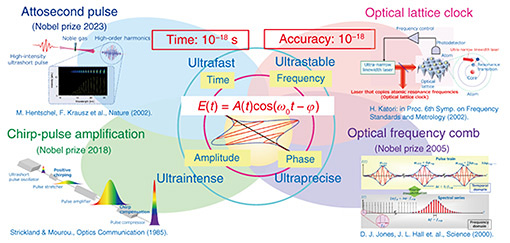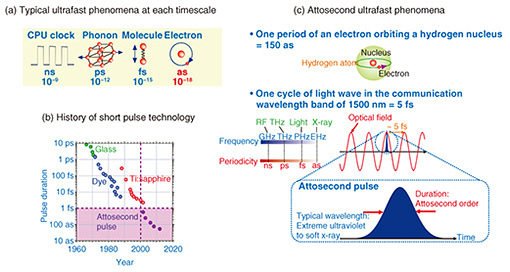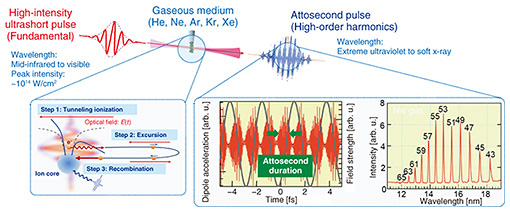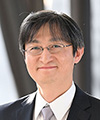 |
|||||||||||||||||||||||||||||||||
|
|
|||||||||||||||||||||||||||||||||
|
Feature Articles: The Frontiers of Ultrafast Optical Physics Research Vol. 23, No. 5, pp. 11–17, May 2025. https://doi.org/10.53829/ntr202505fa1 Prospects for the Frontiers of Ultrafast Optical Physics Research: Engineering Petahertz WavesAbstractThe Nobel Prize in Physics in 2023 was awarded for the generation and measurement techniques of an attosecond (an attosecond is 1 °Ŗ 10−18 second) pulse, which has a temporal duration in the attosecond range in wavelength typically from extreme ultraviolet to soft x-ray. The duration of an attosecond pulse is shorter than the period of typical light waves, and on this timescale, light can be reinterpreted as an electric field oscillating at sub-petahertz (PHz = 1015 Hz) frequencies. This article provides an overview of attosecond pulse generation techniques that have paved the way for the era of °»attosecond science°… and introduces the attosecond pulse laser technologies advanced by NTT Basic Research Laboratories, as well as the latest research and prospects of ultrafast optical physics focusing on petahertz electric field-electron interaction. Keywords: ultrafast optical physics, attosecond science, petahertz wave 1. Extreme control technologies for light and petahertz wavesIn various optical communication technologies, including optical networks and optical devices, which form the core of NTT’s business, we regularly use light. In this context, we typically use units such as nm in wavelength or eV in photon energy to characterize light. However, as high school students learn, light is an electromagnetic wave, and its physics is the same as other electromagnetic waves such as radio frequency (RF) waves used in mobile communication, differing only in wavelength (or photon energy). Such RF waves can be measured with conventional instruments such as oscilloscopes, with which they are characterized in Hz in frequency or seconds in periodicity, and their phase can be controlled. For example, in the radio channels or mobile communication frequency bands, we commonly express radio waves in terms of their frequency. However, we rarely express light in terms of frequency or periodicity. The reason is simply that the oscillation frequency of light is so high compared with RF waves that it was not possible to measure or control the frequency accurately and because the period of light oscillations is so short that it was impossible to measure it or control the phase of its oscillations. There was no need to consider and use such quantities that cannot be measured or controlled. This was the common thinking regarding light until the 20th century. Soon after the beginning of the 21st century, however, revolutionary breakthroughs in optical technologies had begun to change the common thinking regarding light, i.e., attosecond (as: 10−18 s) pulse (2023 Nobel Prize in Physics) [1], optical lattice clock*1, and optical frequency comb*2 (2005 Nobel Prize in Physics). These cutting-edge breakthroughs, plus chirped pulse amplification*3 (2018 Nobel Prize in Physics), have enabled us to completely measure and control over all parameters that define the wave properties of light, including time, frequency, phase, and amplitude (Fig. 1). Therefore, we can now recognize light as an electromagnetic wave with a period of femtoseconds (fs: 10−15 s) and frequency in the petahertz (PHz: 1015 Hz) range. Light can now be understood as petahertz (PHz) waves, surpassing RF waves in terms of bandwidth, precision, and intensity. New frontiers will be opened by engineering PHz waves and breaking through the conventional limits of optical technology [2]. This article focuses on the cutting-edge optical techniques that capture PHz electric field oscillations in the time domain, particularly attosecond pulse generation, attosecond time-resolved measurement techniques, and research on attosecond-timescale-electron dynamics, highlighting ultrafast optical physics research at NTT Basic Research Laboratories (NTT BRL).
2. What is an attosecond pulse?Since the invention of the laser, the development of short pulse lasers began, and techniques to shorten pulse durations to nanoseconds (ns: 10−9 s), picoseconds (ps: 10−12 s), and eventually femtoseconds progressed smoothly (Fig. 2(b)). The advances in short pulse laser technology have made it possible to observe various ultrafast phenomena in materials at each timescale (Fig. 2(a)). However, in the 1990s, the progress in femtosecond pulse technology was temporarily stalled with pulses of several femtoseconds. The breakthrough that overcame this barrier and opened the door to the attosecond timescale was the attosecond pulse generation technology demonstrated in 2001. Let us imagine how fast an attosecond timescale is. A typical example is the motion of an electron around a hydrogen atom (Fig. 2(c) above). Assuming that the electron is moving in a classical circular orbit with the Bohr radius*4, the motion of the electron can be considered to have a period of approximately 150 as. Let us also consider the period of light in the optical communication wavelength range, which is familiar to us. Assuming a communication wavelength of 1.5 μm, one cycle period of light corresponds to approximately 5000 as (Fig. 2(c) below). Therefore, what we usually recognize as “instantaneous movements” can be reinterpreted as phenomena occurring over finite timescales when observed on the attosecond timescale. The attosecond pulse is a powerful tool for measuring such instantaneous movements in materials.
When an attosecond pulse with a duration much shorter than the movement of the object being measured is used to illuminate the object, it captures the snapshot of the movement. By timing subsequent measurements slightly offset in time, it is possible to sequentially capture the full movement across various time intervals, and by arranging the captured snapshots in chronological order, a movie that reproduces the entire movement can be created. The sharpness with which these instantaneous moments can be measured is limited by the temporal duration of the attosecond pulse. Prior to the advent of attosecond pulses, the shortest timescales that could be measured were in the femtosecond range. Professor Ahmed Zewail received the Nobel Prize in Chemistry in 1999 for femtosecond time-resolved spectroscopy probing chemical reactions. The breakthrough to the attosecond timescale represents a dramatic improvement in the shortest timescale measurable by humans, shifting it from the femtosecond range to orders of magnitude shorter. For this reason, the 2023 Nobel Prize in Physics was awarded to Professors Pierre Agostini, Ferenc Krausz, and Anne L’Huillier for their contributions to the development of experimental techniques for generating and measuring attosecond pulses, advancing the study of electron dynamics in materials [3–5].
3. Generation of attosecond pulsesAttosecond pulses are generated through the high-order harmonic generation (HHG) process induced by focusing high-intensity ultrashort pulse lasers in the typical wavelength region from mid-infrared to visible into rare gas atoms. The mechanism of HHG is well understood using the intuitive three-step model [6] (Fig. 3, lower left). When a high-intensity and linearly polarized ultrashort fundamental pulse focused to a peak intensity of around 1014 W/cm2 is irradiated into a rare gas atom, the intensity of the pulse becomes maximum near the pulse peak. At the crests and troughs of the electric field oscillation of the pulse near the pulse peak, the potential barrier binding of the outermost electrons in the rare gas atom is instantaneously distorted by the strong electric field, enabling the electrons to escape from the potential barrier through the tunneling effect and ionize (Step 1: Tunneling ionization). Next, the ionized electrons are accelerated by the subsequent electric field, gaining kinetic energy as they return to the vicinity of the original ionized atom when the electric field direction reverses (Step 2: Excursion). Finally, with a certain probability, the electrons recombine with the ion core, emitting high-order harmonics, the energy of which corresponds to the kinetic energy acquired during excursion and ionization energy during recombination (Step 3: Recombination). The wavelength of the emitted high harmonics typically extends into extreme ultraviolet to soft x-ray. The high harmonics correspond to attosecond pulses. Since this process repeats exactly every half-cycle of the fundamental pulse, the attosecond pulse is emitted in a series of pulses every half-period of the fundamental pulse (Fig. 3, lower middle). When measured in the frequency domain, the harmonic order increases every two fundamental periods, with only odd-order harmonics being emitted (Fig. 3, lower right). The spectral bandwidth of the high-order harmonics typically ranges from several to tens of electronvolts. In the time domain, high-order harmonics become a pulse with a temporal duration inversely proportional to the spectral bandwidth, corresponding to time durations ranging from several tens to hundreds of attoseconds, when the harmonic spectrum covering such a broad spectral bandwidth with several to tens of electronvolts. This is the fundamental principle of attosecond pulse generation.
As described above, attosecond pulses are usually generated as a train of attosecond pulses emitting at every half-period of the fundamental pulse. It is also possible to generate only a single pulse rather than a pulse train (isolated attosecond pulse). The simplest method for this is to shorten the pulse width of the fundamental pulse as much as possible and ideally use a monocycle pulse where the electric field oscillates only once in the pulse as the fundamental pulse. Isolated attosecond pulses can be used as probe light in attosecond time-resolved spectroscopy, which is introduced in the next section. 4. Attosecond science—light-matter interactions at attosecond timescalesOne of the most important developments of attosecond pulse technology is the visualization of extremely fast phenomena (attosecond movies). One example of an extremely fast phenomena is the attosecond timescale dynamical phenomena in light-matter interactions. Consider, for example, the interaction between light and electrons in semiconductors, which form the principles behind devices such as photodetectors [7]. The simplest model described in semiconductor textbooks is that when light irradiates a semiconductor, the electron system absorbs photon energy, and an electronic transition occurs from the valence band to the conduction band*5. In this model, light is merely responsible for instantaneously transferring energy to the electron system, without accounting for the PHz oscillations of the electric field. Similarly, when considering the interaction of electrons with light, it is assumed that the electrons “instantaneously” transition to a higher energy state, without accounting for the motion induced by the PHz electric field of the light. However, as mentioned earlier, when light is reconsidered as a PHz wave, the attosecond timescale interaction dynamics of the electron system driven by the light’s electric field forces us to ask the following main research question: What state or motion does the electron undergo during the cycle of light wave ranging over a few thousand attoseconds? Even the most fundamental light-matter interactions, which are described in conventional textbooks as if they were completely understood, are unclarified when viewed in the attosecond timescale. The technique of visualizing ultrafast phenomena with attosecond pulses provides the most effective experimental answer to this question. Attosecond science is the research field that creates light sources, measurement, and spectroscopic techniques with attosecond temporal resolution, and uses these techniques to clarify attosecond timescale phenomena in various material systems.
5. Recent research activities at NTT BRLIn the Feature Articles in this issue, we discuss four recent topics regarding the progress of attosecond science and technology at NTT BRL. A brief overview is provided here, and more details can be found in the individual articles. 5.1 Megahertz-repetition-rate 1.7-cycle intense pulse sources for future bright attosecond spectroscopyThe first article [8] introduces the development of a high-intensity and sub-two-cycle pulse source that drives attosecond pulse generation. The technology of ytterbium (Yb)-based laser amplifiers, capable of high average output power and high repetition rates, has rapidly advanced, replacing conventional titanium-sapphire (Ti:sapphire) laser amplifiers that were the primary drivers of the first-generation attosecond pulse generation. Although the typical pulse width of Yb-based lasers is over 200 fs, which is much longer than typical 15-fs pulses achievable with Ti:sapphire lasers, the higher average power over 100 W and tunable repetition rates up to several megahertz make them promising for developing few-cycle pulse drivers for isolated attosecond pulse generation with unprecedentedly high brightness and repetition rate. 5.2 Topological high-harmonic generation from solidsAt NTT BRL, the research on HHG from rare gas atoms has led to advancements in controlling the harmonic pulse parameters such as temporal duration, wavelength, and output power. The second article [9] introduces research on using solids as the medium, where the spatial symmetry of the crystal is used to control the spatial phase (wavefront) of high-order harmonic pulses. The ability to control wavefront shapes will result in the generation of topological high-order harmonics, which combine attosecond duration with unique wavefront shapes. This opens new avenues for expanding applications of attosecond pulses. This study also found that simple transformation rules for topological HHG in solids are based on a general law that reflects the symmetry of solids. 5.3 Attosecond time-resolved spectroscopy for light-electron interaction in solid-state materialsThe most fundamental time-resolved measurement technique using attosecond pulses is pump-probe-type attosecond time-resolved spectroscopy, which combines ultrashort pulse light and high-order harmonic pulses. Attosecond time-resolved spectroscopy began immediately after the achievement of single attosecond pulse generation in 2001 and was initially applied to the measurement of electronic dynamics in atomic gases. In the 2010s, solid-state electronic systems were targeted, and short-pulse light pump-single attosecond pulse probe-type absorption spectroscopy became the standard. The third article [10] discusses our leading achievements in attosecond time-resolved spectroscopy, resulting in the observation of light-induced nonlinear polarization with PHz frequency. 5.4 Exploring ultrafast electron dynamics and extreme nonlinear optics induced by intense optical fieldWhen light is reconsidered as a PHz wave, interactions between the lightwave field and matter at timescales shorter than one cycle of the light wave become crucial. The fourth article [11] discusses the results of quantum dynamics simulations for evaluating electron transition rates by tunneling in semiconductors and insulators impacted by high-intensity light fields. This study constructed a theoretical model incorporating electron-hole interactions and showed how electron-electron interactions impact tunneling transition probabilities. These theoretical and simulation studies provide a powerful methodology for understanding electron dynamics on the attosecond timescale beyond the approximate framework assumed by conventional optical science and for analyzing experimental results. 6. Future perspectivesIn the Feature Articles in this issue, we discuss the progress of attosecond pulse technology and attosecond science from both theoretical and experimental perspectives. The Nobel committee for physics commented that attosecond pulses have transitioned from the stage of generation to that of application. Our research on electron dynamics on the attosecond timescale using attosecond pulses has been pioneering in this direction. Our research explores the boundaries of conventional light-matter interactions, which have traditionally relied on perturbation theory, by moving beyond these conventional frameworks. We believe that the application of attosecond pulses, with time durations on the same scale as the natural timescales of electron motion, has great potential, with the goal being PHz-wave-driven electron control on the attosecond timescale, enabling breakthroughs for many applications. References
|
|||||||||||||||||||||||||||||||||












